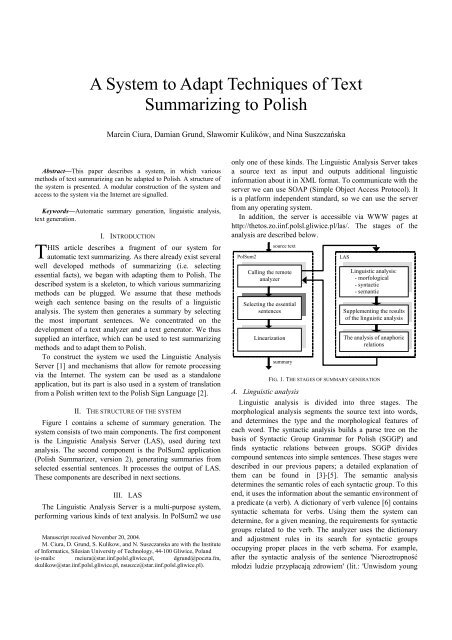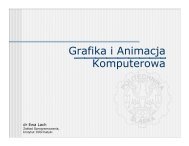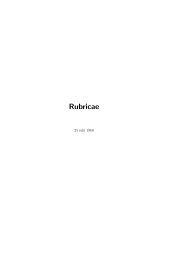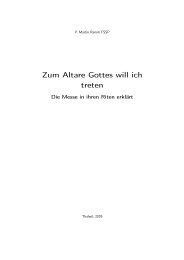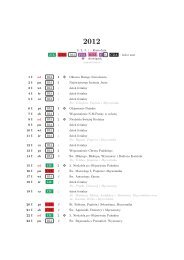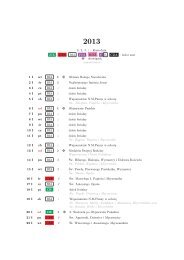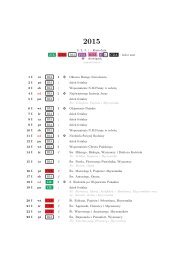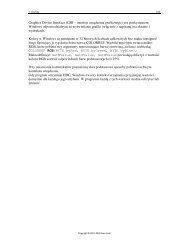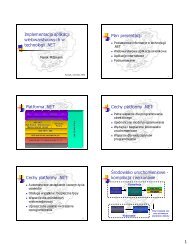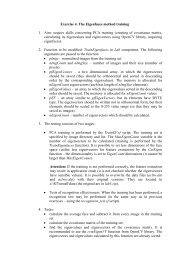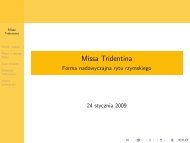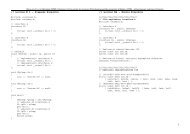A System to Adapt Techniques of Text Summarizing to Polish
A System to Adapt Techniques of Text Summarizing to Polish
A System to Adapt Techniques of Text Summarizing to Polish
You also want an ePaper? Increase the reach of your titles
YUMPU automatically turns print PDFs into web optimized ePapers that Google loves.
A <strong>System</strong> <strong>to</strong> <strong>Adapt</strong> <strong>Techniques</strong> <strong>of</strong> <strong>Text</strong><br />
<strong>Summarizing</strong> <strong>to</strong> <strong>Polish</strong><br />
Marcin Ciura, Damian Grund, Sławomir Kulików, and Nina Suszczańska<br />
Abstract—This paper describes a system, in which various<br />
methods <strong>of</strong> text summarizing can be adapted <strong>to</strong> <strong>Polish</strong>. A structure <strong>of</strong><br />
the system is presented. A modular construction <strong>of</strong> the system and<br />
access <strong>to</strong> the system via the Internet are signalled.<br />
Keywords—Au<strong>to</strong>matic summary generation, linguistic analysis,<br />
text generation.<br />
I. INTRODUCTION<br />
HIS article describes a fragment <strong>of</strong> our system for<br />
Tau<strong>to</strong>matic text summarizing. As there already exist several<br />
well developed methods <strong>of</strong> summarizing (i.e. selecting<br />
essential facts), we began with adapting them <strong>to</strong> <strong>Polish</strong>. The<br />
described system is a skele<strong>to</strong>n, <strong>to</strong> which various summarizing<br />
methods can be plugged. We assume that these methods<br />
weigh each sentence basing on the results <strong>of</strong> a linguistic<br />
analysis. The system then generates a summary by selecting<br />
the most important sentences. We concentrated on the<br />
development <strong>of</strong> a text analyzer and a text genera<strong>to</strong>r. We thus<br />
supplied an interface, which can be used <strong>to</strong> test summarizing<br />
methods and <strong>to</strong> adapt them <strong>to</strong> <strong>Polish</strong>.<br />
To construct the system we used the Linguistic Analysis<br />
Server [1] and mechanisms that allow for remote processing<br />
via the Internet. The system can be used as a standalone<br />
application, but its part is also used in a system <strong>of</strong> translation<br />
from a <strong>Polish</strong> written text <strong>to</strong> the <strong>Polish</strong> Sign Language [2].<br />
II. THE STRUCTURE OF THE SYSTEM<br />
Figure 1 contains a scheme <strong>of</strong> summary generation. The<br />
system consists <strong>of</strong> two main components. The first component<br />
is the Linguistic Analysis Server (LAS), used during text<br />
analysis. The second component is the PolSum2 application<br />
(<strong>Polish</strong> Summarizer, version 2), generating summaries from<br />
selected essential sentences. It processes the output <strong>of</strong> LAS.<br />
These components are described in next sections.<br />
III. LAS<br />
The Linguistic Analysis Server is a multi-purpose system,<br />
performing various kinds <strong>of</strong> text analysis. In PolSum2 we use<br />
Manuscript received November 20, 2004.<br />
M. Ciura, D. Grund, S. Kulikow, and N. Suszczanska are with the Institute<br />
<strong>of</strong> Informatics, Silesian University <strong>of</strong> Technology, 44-100 Gliwice, Poland<br />
(e-mails: mciura@star.iinf.polsl.gliwice.pl, dgrund@poczta.fm,<br />
skulikow@star.iinf.polsl.gliwice.pl, nsuszcz@star.iinf.polsl.gliwice.pl).<br />
only one <strong>of</strong> these kinds. The Linguistic Analysis Server takes<br />
a source text as input and outputs additional linguistic<br />
information about it in XML format. To communicate with the<br />
server we can use SOAP (Simple Object Access Pro<strong>to</strong>col). It<br />
is a platform independent standard, so we can use the server<br />
from any operating system.<br />
In addition, the server is accessible via WWW pages at<br />
http://the<strong>to</strong>s.zo.iinf.polsl.gliwice.pl/las/. The stages <strong>of</strong> the<br />
analysis are described below.<br />
PolSum2<br />
source text<br />
Calling the remote<br />
analyzer<br />
Selecting the essential<br />
sentences<br />
Linearization<br />
summary<br />
LAS<br />
Linguistic analysis:<br />
- morfological<br />
- syntactic<br />
- semantic<br />
Supplementing the results<br />
<strong>of</strong> the linguistic analysis<br />
The analysis <strong>of</strong> anaphoric<br />
relations<br />
FIG. 1. THE STAGES OF SUMMARY GENERATION<br />
A. Linguistic analysis<br />
Linguistic analysis is divided in<strong>to</strong> three stages. The<br />
morphological analysis segments the source text in<strong>to</strong> words,<br />
and determines the type and the morphological features <strong>of</strong><br />
each word. The syntactic analysis builds a parse tree on the<br />
basis <strong>of</strong> Syntactic Group Grammar for <strong>Polish</strong> (SGGP) and<br />
finds syntactic relations between groups. SGGP divides<br />
compound sentences in<strong>to</strong> simple sentences. These stages were<br />
described in our previous papers; a detailed explanation <strong>of</strong><br />
them can be found in [3]-[5]. The semantic analysis<br />
determines the semantic roles <strong>of</strong> each syntactic group. To this<br />
end, it uses the information about the semantic environment <strong>of</strong><br />
a predicate (a verb). A dictionary <strong>of</strong> verb valence [6] contains<br />
syntactic schemata for verbs. Using them the system can<br />
determine, for a given meaning, the requirements for syntactic<br />
groups related <strong>to</strong> the verb. The analyzer uses the dictionary<br />
and adjustment rules in its search for syntactic groups<br />
occupying proper places in the verb schema. For example,<br />
after the syntactic analysis <strong>of</strong> the sentence 'Nieroztropność<br />
młodzi ludzie przypłacają zdrowiem' (lit.: 'Unwisdom young
people they-pay with-health', 'The youth pay for their<br />
unwisdom with their health'), we get four syntactic groups:<br />
• NG1 – nieroztropność (unwisdom)<br />
• NG2 – młodzi ludzie (young people)<br />
• NG3 – zdrowiem (with-health)<br />
• VG1 – przypłacają (they-pay)<br />
All these groups are combined <strong>to</strong> a sentence S1 =<br />
{NG1,NG2,NG3,VG1}, based on the verb group VG1. For<br />
VG1 we find in the dictionary a schema:<br />
Ngn1+VG1+Ngac-c2+NGi3. Then we assign the syntactic<br />
groups <strong>to</strong> the schema. There is a result:<br />
• subject: NG1 or NG2<br />
• predicate: VG1<br />
• object in accusative case: NG1<br />
• object in instrumental case: NG3<br />
There are two candidates <strong>to</strong> be a subject, but NG1 is the<br />
only one candidate <strong>to</strong> be an object in accusative case, so NG2<br />
is the subject. In this case a full semantic analysis <strong>of</strong> syntactic<br />
groups is not required.<br />
B. Supplementing the results <strong>of</strong> the linguistic analysis<br />
Missing elements <strong>of</strong> a syntactic schema <strong>of</strong> a sentence are<br />
determined basing on the results <strong>of</strong> the semantic analysis.<br />
Either a subject, an object, or a predicate can be missing. If<br />
necessary, the results <strong>of</strong> the analysis are supplemented by a<br />
predicate group (VG) or a subject or object group (NG).<br />
Syntactic schemata are also used here. After assigning the<br />
syntactic groups <strong>to</strong> the schema, the schema can be partially<br />
filled. This situation occurs when some syntactic group from<br />
the sentence is an anaphora. We can read syntactic features,<br />
semantic features, and a syntactic role <strong>of</strong> the anaphora from<br />
the schema. Then the analysis <strong>of</strong> anaphoric relations is more<br />
precise. If the anaphora is an ellipsis, then we add a proper<br />
pronoun as a subject or an object. If a predicate is missing,<br />
then we add the verb 'być' ('<strong>to</strong> be') in a proper form. The<br />
algorithm <strong>of</strong> supplementing the missing words is not so<br />
sophisticated. In a future version we plan <strong>to</strong> improve it, using<br />
an analysis <strong>of</strong> ellipses.<br />
C. The analysis <strong>of</strong> anaphoric relations<br />
The analysis <strong>of</strong> anaphoric relations is divided in<strong>to</strong> three<br />
stages: searching for an anaphora, searching for a target <strong>of</strong> the<br />
anaphora, and determining how <strong>to</strong> substitute the target for the<br />
anaphora. As a result, we get information about sentence<br />
interconnections, and how <strong>to</strong> keep these connections, i.e.<br />
which form <strong>of</strong> the target has <strong>to</strong> be substituted for an anaphora.<br />
The problem <strong>of</strong> anaphoric relations analysis [7]-[9] is<br />
complex, so we focused only on some subset <strong>of</strong> anaphora. At<br />
present we take only pronouns and some conjunctions [10]<br />
in<strong>to</strong> account. It should be noticed that a missing subject is<br />
supplemented by a pronoun in a previous stage<br />
(supplementing the results <strong>of</strong> the linguistic analysis). We do<br />
not take in<strong>to</strong> account such anaphoras that repeat some notion,<br />
which occurred earlier in the source text. To take in<strong>to</strong> account<br />
these anaphoras we should use a database <strong>of</strong> term dependency,<br />
for example thesaurus.<br />
We made assumptions while searching for anaphora targets<br />
(antecedents): we look only backward in the scope <strong>of</strong> two<br />
simple sentences (we do not look forward), we take in<strong>to</strong><br />
account only separate words. Since an anaphora can target <strong>to</strong><br />
another anaphora, so indirectly the scope is wider than two<br />
sentences. We select an antecedent from candidates using the<br />
following criterion:<br />
• it must belong <strong>to</strong> a noun group (NG)<br />
• its gender must match with the gender <strong>of</strong> anaphora<br />
• if it is an anaphora, then it must be joined with an<br />
antecedent<br />
If there are still some candidates left, then we select from<br />
them exactly one. A function <strong>of</strong> a syntactical group containing<br />
the antecedent is the main criterion <strong>of</strong> selecting the<br />
antecedent. The preference is as follows (the most important is<br />
the first):<br />
• subject function<br />
• other function (for example object)<br />
• no function<br />
As a result it returns the information how <strong>to</strong> substitute the<br />
antecedent for the anaphora. This information can be used by<br />
the system or not. To perform this substitution, we take the<br />
base form and the type from the antecedent, but the features<br />
from the anaphora. If the anaphora features and the antecedent<br />
features differ, then we have two solutions: generate a proper<br />
form <strong>of</strong> the antecedent or leave the base form. Since <strong>Polish</strong> is<br />
an inflected language, we try <strong>to</strong> generate a proper form <strong>of</strong><br />
antecedent. In this way the generated text is more readable by<br />
human.<br />
To generate a proper form <strong>of</strong> antecedent we use<br />
morphological database [11]. The morphological database<br />
contains a morphological description <strong>of</strong> over 50 thousand<br />
<strong>Polish</strong> words, including over 30 thousand nouns (presently<br />
only nouns take part in anaphora resolution). It is s<strong>to</strong>red in an<br />
acyclic finite-state au<strong>to</strong>ma<strong>to</strong>n that represents the relation<br />
between text forms and words with their grammatical<br />
attributes. While the database recognizes variant word forms<br />
(which occur in 1 <strong>Polish</strong> noun out <strong>of</strong> 8) when used <strong>to</strong> analyze<br />
texts, it outputs only the most prevalent variant form when<br />
used <strong>to</strong> generate texts.<br />
The use <strong>of</strong> this database required creating an interface layer<br />
because the set <strong>of</strong> grammatical attributes used in the database<br />
differs from that used in the system. Specifically, all requests<br />
are translated from a 3-gender, 7-case system in<strong>to</strong> a 4-gender,<br />
8-case one. Also, the system distinguishes the nouns<br />
according <strong>to</strong> their nominative form, while the database takes<br />
in<strong>to</strong> account the whole declension paradigm. The format <strong>of</strong><br />
the request is: (a noun in nominative, its gender [masculine,<br />
feminine or neuter], its number [singular or plural], its case<br />
[nominative, genitive, dative, accusative, instrumental,<br />
locative, vocative]).<br />
Example nouns that decline differently depending on their<br />
meaning are: 'pilot' ('pilot' or 'remote control'), 'rząd'<br />
('government' or 'row'). For such nouns a set <strong>of</strong> pairs (possible<br />
form, internal code <strong>of</strong> the noun) is generated. To distinguish
them we try <strong>to</strong> identify them on morphological level. We<br />
generate an antecedent form using its features and then we<br />
search for a matching candidate. Such method was used in<br />
example in Figure 2.<br />
Since we use only the morphological level, we can<br />
distinguish the meaning <strong>of</strong> words only in the same case.<br />
Usually they are distinguishable in genitive case and<br />
accusative case. Since the method <strong>of</strong> searching for an<br />
anaphora or for an antecedent is a heuristics, it is possible <strong>to</strong><br />
make a mistake. To improve it, we should use semantic<br />
features. Among such features we should mainly use<br />
semantic gender, which sometimes is different than<br />
morphological gender.<br />
IV. POLSUM2<br />
PolSum2 is a new version <strong>of</strong> the PolSumm application [12].<br />
We focused on providing mechanisms that facilitate adapting<br />
various summarizing methods. We thus developed a test bed<br />
for these methods. The stages <strong>of</strong> summarizing are described<br />
below.<br />
A. Calling the remote analyzer<br />
In this stage we only communicate with the LAS server.<br />
The source text is sent <strong>to</strong> the server, and the results <strong>of</strong> the<br />
analysis are received.<br />
B. Selecting the essential sentences<br />
In this stage the essential sentences are identified. These<br />
sentences will be selected <strong>to</strong> a summary. Researchers are<br />
provided with a coherent environment <strong>to</strong> implement and test<br />
their methods.<br />
The essential sentences have a high weight, computed for<br />
each simple sentence from the results <strong>of</strong> source text analysis.<br />
Since the anaphoras are substituted, we can select among<br />
more sentences, because any text composed <strong>of</strong> them is<br />
coherent. Otherwise we would have <strong>to</strong> select among<br />
compound sentences or blocks <strong>of</strong> sentences <strong>to</strong> keep the<br />
resulting text coherent. In this way the building blocks <strong>of</strong> the<br />
summary are smaller than sentences (we do not need <strong>to</strong> select<br />
all compound sentences). But there are some disadvantages <strong>to</strong><br />
this approach. We sometimes do not analyze all the<br />
interconnections between the sentences, so the generated<br />
summary can consist <strong>of</strong> sentences with broken connections.<br />
We assume that the user chooses how many essential<br />
simple sentences should be selected <strong>to</strong> the summary, as a<br />
numeric range. These sentences are copied (sometimes with<br />
modifications) from the source text <strong>to</strong> the summary,<br />
preserving their order.<br />
C. Linearization<br />
In this stage a textual form <strong>of</strong> each sentence is generated.<br />
<strong>Text</strong> generation is divided in<strong>to</strong> two threads. The first thread is<br />
a generation <strong>of</strong> proper form <strong>of</strong> words. The second one is a<br />
generation <strong>of</strong> sentence, in other words <strong>to</strong> place generated<br />
words in proper position in the sentence.<br />
Generation <strong>of</strong> words is used only for antecedents in case <strong>of</strong><br />
substitution (other words are already in proper form in the<br />
source text). In this stage we only use results from the analysis<br />
or anaphoric relations, since there is given a way <strong>of</strong><br />
substitution.<br />
In addition we reduce homonyms for the same word, where<br />
various variants appear during morphological analysis. When<br />
we generate text we may lose morphological information.<br />
Information about substitution for anaphora need not be<br />
used when two simple sentences with an anaphoric relation<br />
were selected <strong>to</strong> the summary. We may leave this relation, so<br />
the generated summary is “more natural” for the reader. In<br />
some cases it is possible that these simple sentences become<br />
transformed in<strong>to</strong> a compound sentence.<br />
We assumed that we do not change the order <strong>of</strong> words, so<br />
<strong>to</strong> generate text <strong>of</strong> the summary we place generated words in<br />
the same order as they appear in the source text.<br />
Figure 2 shows an example <strong>of</strong> text generation. The source<br />
text consists <strong>of</strong> three sentences with anaphoric relations (with<br />
use <strong>of</strong> pronouns). Moreover, an example <strong>of</strong> identifying the<br />
word on the morphological level (described in section III C) is<br />
presented there. The base form <strong>of</strong> the word 'rzędzie' (row) is<br />
'rząd' ('row' or 'government'), but after identifying the word we<br />
use the form 'rzędu' (row) not 'rządu' (government) for<br />
substitution for anaphora. After text generation with<br />
substitution for anaphora we get sentences that can exist<br />
separately without significant loss <strong>of</strong> meaning.<br />
Ja jestem w rzędzie. On jest daleko. Mój przyjaciel idzie do niego.<br />
(I am in a row. It is far away. My friend goes <strong>to</strong> it.)<br />
Ja jestem w rzędzie. Rząd jest daleko. Mój przyjaciel idzie do rzędu.<br />
(I am in a row. The row is far away. My friend goes <strong>to</strong> the row.)<br />
FIG. 2. EXAMPLE OF TEXT GENERATION WITH SUBSTITUTION FOR ANAPHORA<br />
V. CONCLUSION<br />
This paper presents a system which helps <strong>to</strong> adapt<br />
summarizing methods for <strong>Polish</strong> and <strong>to</strong> test them. It is a<br />
pro<strong>to</strong>type, so some improvements are needed. We should take<br />
in<strong>to</strong> account anaphoric relations via repetition <strong>of</strong> the same<br />
notion, and in general we should improve the heuristics <strong>of</strong><br />
anaphora relations analysis and text generation. It should be<br />
noted that the system is built from modules, so any part <strong>of</strong> the<br />
system can be changed (and <strong>of</strong> course the part responsible for<br />
the selection <strong>of</strong> the essential sentences should be changed<br />
<strong>of</strong>ten). On the other hand the system has some disadvantages.<br />
The primary disadvantage is that it supports only these<br />
summarizing methods that are based on selecting sentences<br />
from the source text.<br />
REFERENCES<br />
[1] S. Kulików. Implementation <strong>of</strong> Linguistic Analysis Server for The<strong>to</strong>s –<br />
<strong>Polish</strong> <strong>Text</strong> in<strong>to</strong> Sign Language Transla<strong>to</strong>r. Studia Informatica, vol. 24,<br />
no. 3 (55), Gliwice 2003, pp. 171-178 (in <strong>Polish</strong>)<br />
[2] P. Szmal, S. Kulików. Support for Deaf People at Web Browsing. 3rd<br />
IASTED International Conference Artificial Intelligence and<br />
Applications AIA'2003, Benalmadena, Spain 2003, pp. 13-17
[3] N. Suszczańska, M. Lubiński. POLMORPH, <strong>Polish</strong> Language<br />
Morphological Analysis Tool. 19th IASTED International Conference<br />
Applied Informatics AI'2001, Innsbruck, Austria 2001, pp. 84-89<br />
[4] N. Suszczańska, P. Szmal, J, Francik, Translating <strong>Polish</strong> <strong>Text</strong>s in<strong>to</strong> Sign<br />
Language in the TGT <strong>System</strong>. 20th IASTED International<br />
Multi-Conference Applied Informatics AI'2002, Innsbruck, Austria<br />
2002, pp. 282-287<br />
[5] P. Szmal, N. Suszczańska. Selected Problems <strong>of</strong> Translation from the<br />
<strong>Polish</strong> Written Language <strong>to</strong> the Sign Language. Archiwum Informatyki<br />
Teoretycznej i S<strong>to</strong>sowanej 13(1), 2001, pp. 37-51<br />
[6] D. Grund. Komputerowa implementacja słownika syntaktyczno-generatywnego<br />
czasowników polskich. Studia Informatica, Vol.21, No 3 (41),<br />
2000, pp. 243-256 (in <strong>Polish</strong>)<br />
[7] M. Dalrymple. The Syntax <strong>of</strong> Anaphoric Binding. Stanford, CSLI<br />
Publications, 1993. Available: http://csli-publications.stanford.edu/<br />
[8] R. Muskens. Categorial Grammar and Lexical-Functional Grammar.<br />
Proceedings <strong>of</strong> the LFG01 Conference. Stanford, CSLI Publications,<br />
2001<br />
[9] Y. W. Romanyuk. Grammatical Processes <strong>of</strong> <strong>Text</strong> Compression. Ph. D.<br />
Thesis, Institute <strong>of</strong> Linguistics NAN Ukraine, Kyiv 1996 (in Ukrainian)<br />
[10] S. Kulików, J. Romaniuk, N. Suszczańska. A syntactical analysis <strong>of</strong><br />
anaphora in the Polsyn parser. Proceedings <strong>of</strong> the International<br />
IIS:IIPWM'04 Conference, Zakopane 2004, Poland, pp. 444-448<br />
[11] M. Ciura. Rozpoznawanie wyrazów w tekście polskim z zas<strong>to</strong>sowaniem<br />
acyklicznych au<strong>to</strong>matów skończonych. [Recognizing words in <strong>Polish</strong><br />
texts with acyclic finite-state au<strong>to</strong>mata], PhD thesis, Silesian University<br />
<strong>of</strong> Technology, Faculty <strong>of</strong> Au<strong>to</strong>matic Control, Electronics, and<br />
Computer Science, 2004.<br />
[12] N. Suszczańska, S. Kulików. A <strong>Polish</strong> Document Summarizer. 21st<br />
IASTED International Conference AI'2003, Innsbruck 2003, pp.<br />
369-374


